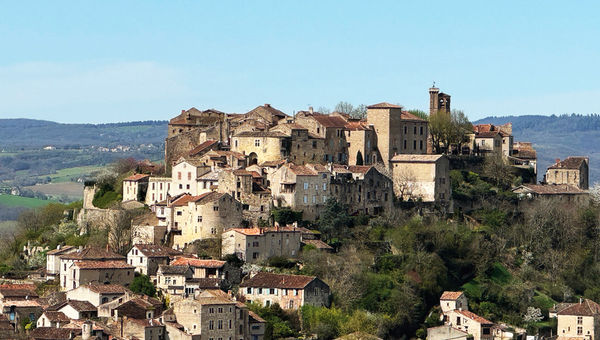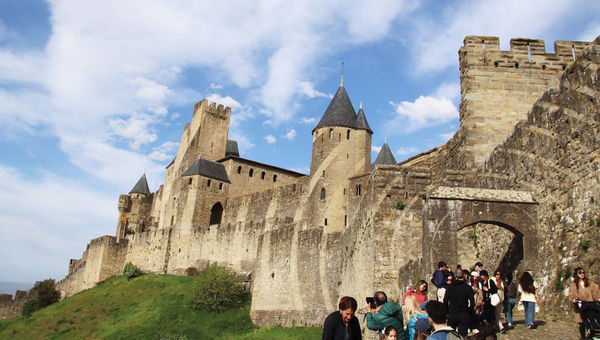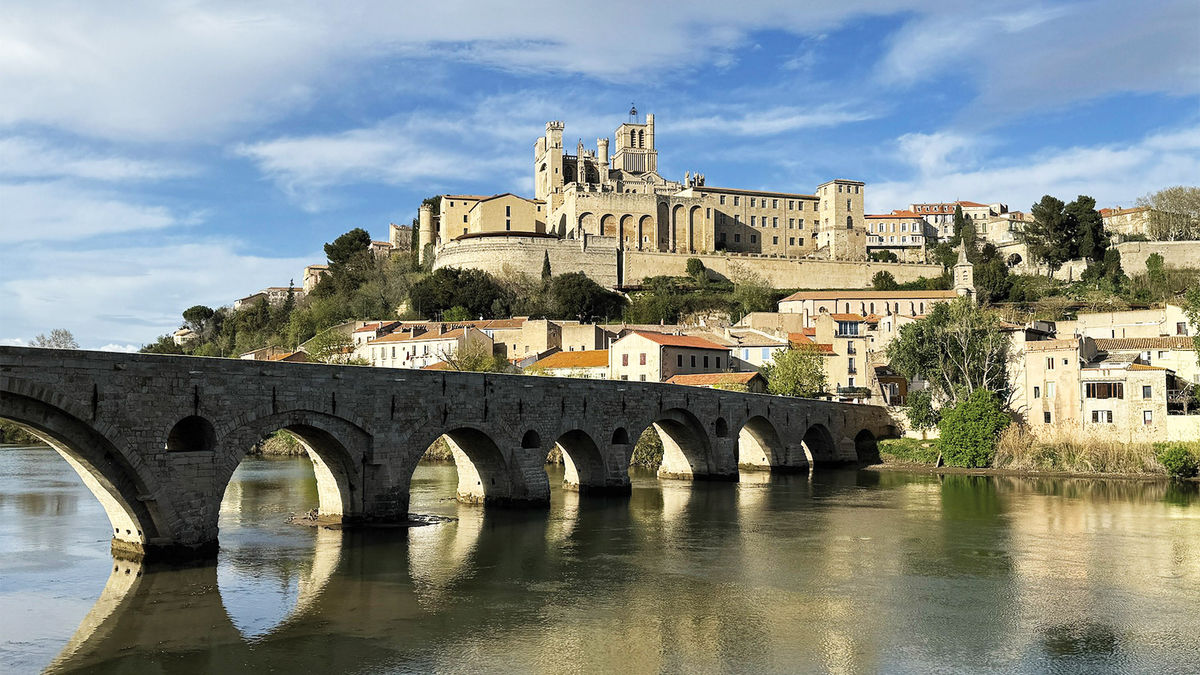BEZIERS, France — Clients don’t have to be history buffs to enjoy a visit to Occitanie. The southernmost region in France is the birthplace of cassoulet and a thriving wine destination that is also an area rich with outcroppings suited to picturesque hilltop villages — and to hiking.
But as visitors on guided tours will discover, Cathar history has influenced the touristic landscape.
With support from Destination Occitanie and local tourism offices, I traveled the rails (with one outing by car) in pursuit of that history.
Albi Cathedral, a Unesco World Heritage Site, was built in the aftermath of the Albigensian Crusade. Photo Credit: Nadine Godwin
In the Middle Ages, this city was part of a cultural area known as Languedoc, where local nobles governed, not French kings, and the language was Occitan, not French. The local culture fostered religious tolerance and gender parity: The cloister at the cathedral here features a plaque honoring six medieval troubadours, including one woman.
Troubadours originated in Languedoc, and the Beziers plaque recalls their 11th-to-13th-century heyday, a time when they traveled to the area’s courts to sing of love.
Then, everything fell apart.
Catharism takes hold
A religious heresy called Catharism, involving about 5% of the population, had found a home here. Popes wanted to eradicate it, and French kings coveted the land. They got what they wanted.
Their project began in 1209 with a grisly 20-year assault, known as the Albigensian Crusade, against Cathars and their protectors, followed by an inquisition that lasted nearly 100 years.
Today, a significant chunk of the medieval Languedoc comprises the Occitanie region. Toulouse, a power center in Languedoc, is Occitanie’s capital.

The hilltop town of Cordes-sur-Ciel was founded to settle those displaced by the Crusade. Photo Credit: Nadine Godwin
This year, Toulouse’s St. Raymond Museum is sponsoring an exhibit devoted to the Cathars, on view through Jan. 5, at two sites: the museum itself and the city’s Jacobin Church. And visitors will see the Occitan language in public spaces: In several historical town centers, some street signs are written in French and Occitan. (Occitan classes are offered to children and adults in select schools in Occitanie.)
A pass for exploring the past
Clients can undertake their own itineraries with the Occitanie Rail Tour Pass, at 10 euros a day for unlimited Occitanie travel, two to six consecutive days, good on the SNCF (French Railways) and liO Train (regional trains). SNCF provides the platform for booking the pass.
Some of the prime historical points of interest they can visit follow.
• Cordes-sur-Ciel, a hilltop town of about 1,000, exists as a direct result of the Albigensian Crusade. Count Raymond VII of Toulouse founded it in 1222 to provide a place for those who had lost homes in the fighting. A market town, it grew so fast that in the 13th and 14th centuries, it built and rebuilt its walls five times.
Five town gates survive, as do 13th- and 14th-century houses — the oldest is the city hall — and the historical outdoor market site. Today it looks like the ideal perched village, one that charms with small houses, unique shops and appealing dining options. Most residents live toward the bottom of the hill for convenience.
I arrived by car, but Cordes is also accessible using a train/bus combination.
• The centurylong project to build the Dominican Jacobin Church in Toulouse started immediately after the Crusade ended (1230). It is an austere brick structure, designed in part to attract Cathars, who viewed austerity in theology and in life as the ideal.
Now deconsecrated, the church is notable for a line of 95-foot columns dividing its cavernous sanctuary lengthwise. At one end, a single column supports 22 ribs that fan out like palm fronds over the apse.
The relics of St. Thomas Aquinas, a Dominican, are under the altar. An attached cloister is idyllic.
• The Albi Cathedral, where construction began during the Inquisition (in 1282), also presents a simple redbrick exterior in response to Catharism. One view holds the Catholic Church opted for a huge, plain building (371 feet long, 98 feet high in the sanctuary) to demonstrate power, but an alternative view says the plainness was meant to draw Cathars in.
Either way, it’s a striking monument that, after there were no Cathars to impress, gained an ornate entry canopy and 200,000 square feet of frescoes on ceiling and walls — an eye-popping sight.
Its evocative surroundings include a rich collection of medieval houses (the 12th-century Fenasse Hotel the oldest) and the former bishop’s palace, now accommodating the works of and named for native son Toulouse-Lautrec.
Albi gave its name to the Albigensian Crusade.
• Beziers was the first town on the crusaders’ radar. To terrorize the region, the crusaders destroyed Beziers in 1209, killing about 5,000 people, including those in the cathedral when it burned. Another church where citizens unsuccessfully sought refuge, St. Madeleine’s Church, survives.
• Related: Drinking in the picturesque in the Loire Valley
Construction of the new Beziers Cathedral started a few decades later. Sited atop a dramatic promontory with the Orb River and the city’s 12th-century Old Bridge in the foreground, it’s a dream for photographers that very much belies the horror that predated it.
• Carcassonne boasts Europe’s only surviving double set of city walls. Medieval engineers incorporated remains of old Roman fortifications into the inner wall. The outer Carcassonne wall was added in the 13th century because of weaknesses in city defenses revealed during and after the crusaders’ attacks.

The walls of Carcassonne with the effects of the 2018 art installation “Eccentric, Concentric Circles” still visible. Photo Credit: Nadine Godwin
The walls, seen from any angle, have the drama and girth to fulfill the tourist’s visions for a medieval citadel. They have 52 towers and two miles of ramparts. Visitors can walk on the city ramparts as well as those atop the former viscount’s 12th-century castle, which abuts the inner wall.
Carcassonne’s medieval town, a Unesco site, was jumping with visitors during my March visit. It’s a tourist town with a raft of souvenir shops, restaurants and a few hotels plus medieval-themed museums and a Medieval Camp with costumed re-enactors.
Only 35 of the city’s 50,000 residents live in the walled center. But Carcassonne is no less authentic. It must be seen.

